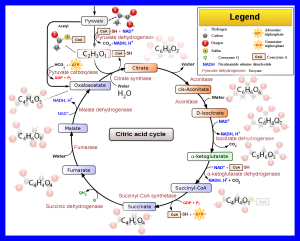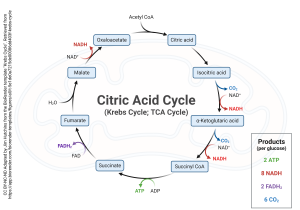The Citric Acid Cycle
Objective 5.7
5.7.1 State the essential features of the citric acid cycle, also called tricarboxylic acid (TCA) cycle or Krebs cycle.
Step 3 – The Citric Acid Cycle

Having come this far, we know there is enough O2 present for aerobic respiration. We can, therefore, continue with the process of cellular respiration and move into the citric acid cycle. Here is the condensed version: Coenzyme A shovels an acetyl group (a 2-carbon molecule) into the citric acid cycle and then returns to the “pile” at the end of Step 2 to pick up another (CoA, as a coenzyme, is not consumed in the reaction). As the acetyl group makes its way around the citric acid cycle, the two carbons are separated, their protons and electrons are carried away by NAD+ and FAD, the two carbons are removed (one at a time) as CO2, and one ATP is formed.
Remember, we started with one glucose, which became two pyruvic acids, which each lost a carbon and were then picked up by a coenzyme A shovel, creating two acetyl coenzyme A molecules. The citric acid cycle can accept only one acetyl group at a time and so “turns” twice for each glucose that enters glycolysis. Each citric acid cycle turn produces two CO2 molecules, three NADH + three H+, one FADH2, and 1 ATP. For each glucose, then, the citric acid cycle produces four CO2, six NADH + six H+, two FADH2, and 2 ATP. This step also occurs in the mitochondrial matrix.
Here is the full, more complicated version (hint—remember the objective and focus on the simpler version…):
Again, the details of this process are not important for students to memorize but are presented here if you want a fuller understanding of the process. There are two versions of this image: the complete version, with all the names of the compounds, ball-and-stick models, and the names of the enzymes.
A slightly-but-not-really-very simplified image of the citric acid cycle is alongside. Here, we’ve covered the ball-and-stick models and supplied the number of carbons, hydrogens, and oxygens in each molecule. This allows you (if you want to — remember, it’s not required) to see where:
- water (H2O) goes in and comes out in hydrolysis and dehydration synthesis reactions, respectively;
- hydrogens (H+ and e–) fill the NAD+ and FAD “buckets”;
- carbon dioxide (CO2) comes out
A hint on CO2: when we lose a carbon, it never comes out alone. Rather, it’s paired up with two oxygen atoms to make CO2. This is why we need oxygen to fuel our cells, and how oxygen is consumed by the process of metabolism. So as we “turn” the citric acid cycle:
- we go from 6-carbon molecules to 5-carbon molecules, creating a CO2
- from 5 carbon molecules to 4-carbon molecules, creating a CO2
- then we add a 2-carbon acetate group to return back to a 6-carbon molecule.

2 turns of this cycle per glucose molecule
Here is the TL;DR version that you do need to know.
Each turn of the citric acid cycle produces:
- 2 CO2;
- 8 hydrogens, carried by NAD+ and FAD;
- 1 ATP made directly
Each glucose molecule is broken down to 2 pyruvates, which then become 2 acetates (CH3COO–), so each glucose molecule turns the citric acid cycle twice. There are six carbons in glucose. Two of those carbons became CO2 at the acetyl-CoA production step. Four of these carbons (2 turns x 2 CO2 per turn) become 4 CO2 molecules as the citric acid cycle turns twice. Presto! All six carbons in glucose are turned into CO2. All the hydrogens we can find (16 altogether, with some being contributed by H2O) are loaded into hydrogen buckets (NAD+ and FAD) and taken to the electron transport chain.
Each glucose molecule (2 turns of the cycle) produces:
- 4 CO2;
- 16 hydrogens, carried by NAD+ and FAD;
- 2 ATPs made directly.
Now that the carbons are all gone, and the energy from carbon-carbon bonds has been turned into ATP, what do we do with all those hydrogens? That’s explained in the next objective.
Some sharp-eyed students may notice a few details that don’t seem to line up. If you don’t want to know, skip ahead to the next objective and you won’t be harmed by not knowing that:
- We didn’t really make ATP directly. We turned guanosine diphosphate (GDP) into guanosine triphosphate (GTP). But that GTP makes a great phosphate donor, and is happy to transfer its terminal phosphate to ADP, forming ATP.
- Most diagrams show FAD carrying 2 hydrogens at the succinic dehydrogenase step (typically shown at about 8 o’clock on the cycle). The detailed diagrams in the blue boxes above show “Q” which is coenzyme Q. It turns out that FAD and coenzyme Q are part of the same complex (called complex II) in the electron transport chain and so the FAD “bucket” is actually physically connected to the electron transport chain.
Media Attributions
- U05-019 citric acid cycle blue box © Narayanese, WikiUserPedia, YassineMrabet, TotoBaggins adapted by Jim Hutchins is licensed under a CC BY-SA (Attribution ShareAlike) license
- U05-020 Citric Acid Cycle © Hutchins, Jim is licensed under a CC BY-NC-ND (Attribution NonCommercial NoDerivatives) license

